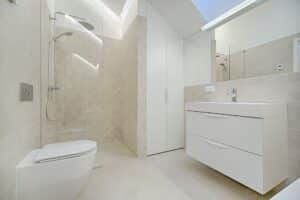There are many options to consider while buying a toilet for your bathroom. Start by writing if you want a traditional or contemporary toilet, a one-piece or two-piece toilet, a plain or colored toilet, then decide on one that meets your needs. Don’t know where to start? Allow this guide to walk you through the various options to consider while buying a toilet.
From taking good care of your most fundamental needs to enhancing your sustainability ratio to making the perfect appearance, there’s a toilet that’s perfect for both you and your budget. Expect to spend somewhere around $100 for a simple toilet to over $7,000 for an ultra-modern toilet with all the bells and whistles.
Moreover, you’ll need to consider a few options while buying a toilet, such as the type of flush you want and whether you want features like a bidet or a heated seat. You’ll also have to think about what the budget permits and the bathroom design.
Other factors to consider are the layout and configuration of your bathroom and the toilets commonly found in neighboring homes in your area.
Types of Toilets

Two-Piece Toilets
These conventional models have different tanks and bowls, making them easier to control, particularly for installations and fitting a toilet into tiny corners. You can seal the water inlet gap and the bolts to tighten the tank to the bowl and secure the seam between the two parts with rubber gaskets.
Although the gaskets will last for years, they will inevitably fail, leading to leakage. Since the bolts and nuts rot and “freeze,” you need to cut and replace the gaskets.
One-Piece Toilet
In this design, the gap between the tank and the bowl isn’t present. As a result, there are no crevices to collect dust.
However, one-piece toilets are usually more costly than two-piece toilets.
Round Front Bowls
Smaller spaces benefit from the snub-nose bowl style. Did you know that the round-front toilet was the only design available until the invention of the elongated toilet?
Elongated Bowls
Towards the front of the toilet, this pear-shaped bowl has many extra inches of bowl room. It’s ideal for people who value having more space.
Standard Bowl Height
The standard bowl height is 14 to 15 inches off the floor, but taller bowls of 17 to 19 inches are becoming more trendy, particularly among the elderly and those with mobility issues.
Wall-Mount Toilets
Instead of resting on the floor, you can attach these versions directly to the wall. Here the tank is hidden within the wall cavity, allowing for more accessible floor space, which is useful in small spaces.
Wall-mount toilets are common in residential layouts because they are easy to maintain underneath the tank, unlike in public toilets. Also, reinforce the wall for retrofits.
Tankless Toilets
A tankless toilet eliminates the need for a water tank by drawing water directly from a supply route linked to the toilet bowl. When there isn’t enough intense force to empty the bowl, like in most solo homes, the flush is driven by pumps or other machines.
Tankless toilets are discreet and have a low profile since there is no tank to refill after each flush. Pump-activated flushing technology requires power, so if the electricity goes out, the toilet won’t function.
Color Options

The color options to consider while buying a toilet are conservative. There are a few types of beige, light blues, greens, and black for the corporate aesthetic.
However, white toilets account for nearly 90% of all toilets sold in the United States.
Flush Variants

Gravity-fed Toilets
As the name implies, gravity-fed toilets use gravity to throw water from the water tank into the bowl, which causes a siphon motion that draws waste back into the sewage pipe. In addition, these tried-and-true pioneers operate admirably in all circumstances.
Pressure-assisted Toilets
Internal tanks are enclosed in these versions. Air pressure rises as these tanks fill with water. When you release this pressure during a flush, it produces a blast of water that aids in the disposal of waste from the toilet.
However, the residual noise is quite noisy, but companies are recently taking action to limit noise in pressure-assisted flush designs.
Power-assisted Toilets
To introduce airflow into a sealed tank, these variants use a low-hp electric motor. The tank contains a set volume of water—1.6 gallons or less—that is squirted out under pressure to flush the waste from the bowl.
High-efficiency Toilets
These toilets have a powerful flush by using the smallest amount of water possible, typically 1.28 gallons per flush (GPF) or less. This expression can refer to any flushing activity.
Dual-flushToilets
Last, this water-saving model promotes “conscious flushing” by asking you to choose between a low-water (0.8 to 1.2 gpf) liquid waste flush or a packed 1.6-gallon solid waste flush. Convenient, right?
Seating Choices

Though comfort is paramount, today’s seats are capable of so much more. Prepare yourself: A top-of-the-line, do-it-all seat will cost upwards of $1,800. Let’s look at a few seating options to consider while buying a toilet.
If you’re looking for a new toilet seat, make sure it’s the right size for your toilet. You should consider the following innovative options while buying a toilet:
Heated seats warm the seat lightly with low-voltage heating coils. To keep the seat warm, you can choose your desired comfort level by adjusting the thermostatic settings.
Bidet-style seats retrofit onto your current toilet to have the cleaning capacity of a bidet. Some bidet seats come with pre-heated water, dual jets (front and back), air drying, and even sensor lighting that can help you navigate your way in the night.
Stop seats from smashing into the toilet bowl with slamless lids that close softly and quietly.
Antimicrobial coatings prevent bacteria and viruses from growing, decreasing mold, mildew, and odors. Besides, silver compounds are the core active components, stable, sterile, human-safe, and will not wash away.
Last, quick-release hinges make it simple to dismantle the current seat for cleaning, an essential feature.






